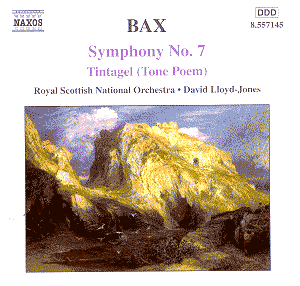With this album Lloyd-Jones’ highly acclaimed
Bax symphonies cycle (with Bax tone poems), for Naxos, begun in
1995, comes to its conclusion.
Bax’s Seventh Symphony, orchestrated at Morar
overlooking the northern Hebridean islands of Rhum, Eigg and Muck,
was completed in January 1939. This was in time to fulfil its
commission for the New York World Fair where it was premiered
in June of that year under Sir Adrian Boult. After, as Lewis Foreman
suggests, in his Bax biography, "the devil that had pursued
him through the earlier six symphonies had been finally laid to
rest in the Epilogue of the Sixth … the Seventh is technically
the most secure and at the same time the most relaxed."
Lloyd-Jones paints a bracing, vividly atmospheric
picture of wind and waves, of surging sea rollers as the accumulative
energy of the first movement is released. This sonic seascape
implies bright and breezy conditions for the music is predominantly
buoyant and sunny, joyful and playful with a typical Baxian long-breathed
lyrical, romantic melody. But Lloyd-Jones also nicely probes the
more troubled aspects of the movement, the mysterious and threatening
harp arpeggios, and wailings and persistent nagging chatter of
the woodwinds, the snarling brass etc. But, at length, the shadows
are dispelled by supremely confident and majestic statements of
natural grandeur
The slow movement was described by Bax as an
"intermezzo and trio" though as Graham Parlett observes
in his notes for this album, intermezzos "are normally not
as extended and eventful as this one." Lloyd-Jones, in the
opening section, suggests a sultry and languorous summer day (I
am tempted to think of this section, as Lloyd-Jones reads it,
as another seascape looking backwards towards Tintagel
with the same sort of sensual undertones). The central Trio follows
a more, enigmatic programme. In Legendary Mood as it is
marked; the music probably implies a Celtic or Northern legend
of romance, heroism and dark monstrous spirits.
The finale is in the form of a Theme and Variations.
It opens with a rousing Prelude, heroic and romantic suggesting
chivalry. It comes as close to ceremonial music as Bax would venture
before his appointment as Master of the King’s Music (a role for
which he was not temperamentally best suited) just a little over
two years into the future. Having created a sense of occasion,
Bax quietens and softens the music to state the theme on cellos
and basses which is then taken up by the upper strings, the music
still in Elgar’s nobilmente mood. The variations of course
cover a variety of moods: wistful and yearning, wild and barbaric,
tender etc.; but as Lewis Foreman points out the actual music
is varied but little other than in rhythmic accentuation and tempo
so the effect is rather that of a passacaglia than a theme and
variations proper. Of the seven variations, the last is the Epilogue
– this time quite short and in a mood that is "curiously
compelling and final". A magical farewell to the world of
Bax’s symphonies, this, by Lloyd-Jones
Lloyd-Jones has saved Bax’s most popular work,
his tone poem, Tintagel until, the last album in the series.
Drafted in 1917 but not completed until January 1919 Tintagel
bears the dedication ‘For darling Tania with love from Arnold’
(Later when published toned down to the demure "To Miss Harriet
Cohen"). It commemorates the idyllic six weeks they had spent
together at Tintagel on the north coast of Cornwall. Bax had run
away from his wife to be with the much-younger Harriet. The music
recalls Wagner’s Tristan and Isolde whose fate was, of
course, tied up with Tintagel. It speaks not only of the tumult
of the waters crashing upon the rocks below the cliffs on which
the ruins of the castle stand, but also the emotional turbulence
the two lovers were experiencing.
Lloyd-Jones pays a magical farewell to the world
of Bax’s symphonies, with this energetic and atmospheric recording
of Bax’s predominantly optimistic final Seventh Symphony coupled
with a surging, powerful reading of Bax’s most popular work Tintagel.
Ian Lace

Looking over the Silver Sands from Morar
toward the Isle of Rhum, Inverness-shire.
Photo by A.G. Macleod
Arnold
Bax Web site
